

Headed to Shoptalk? Join us for free drinks at our after-hours party! Register here.
Didn’t find what you needed? Try searching for it here. Hit enter to search or ESC to close
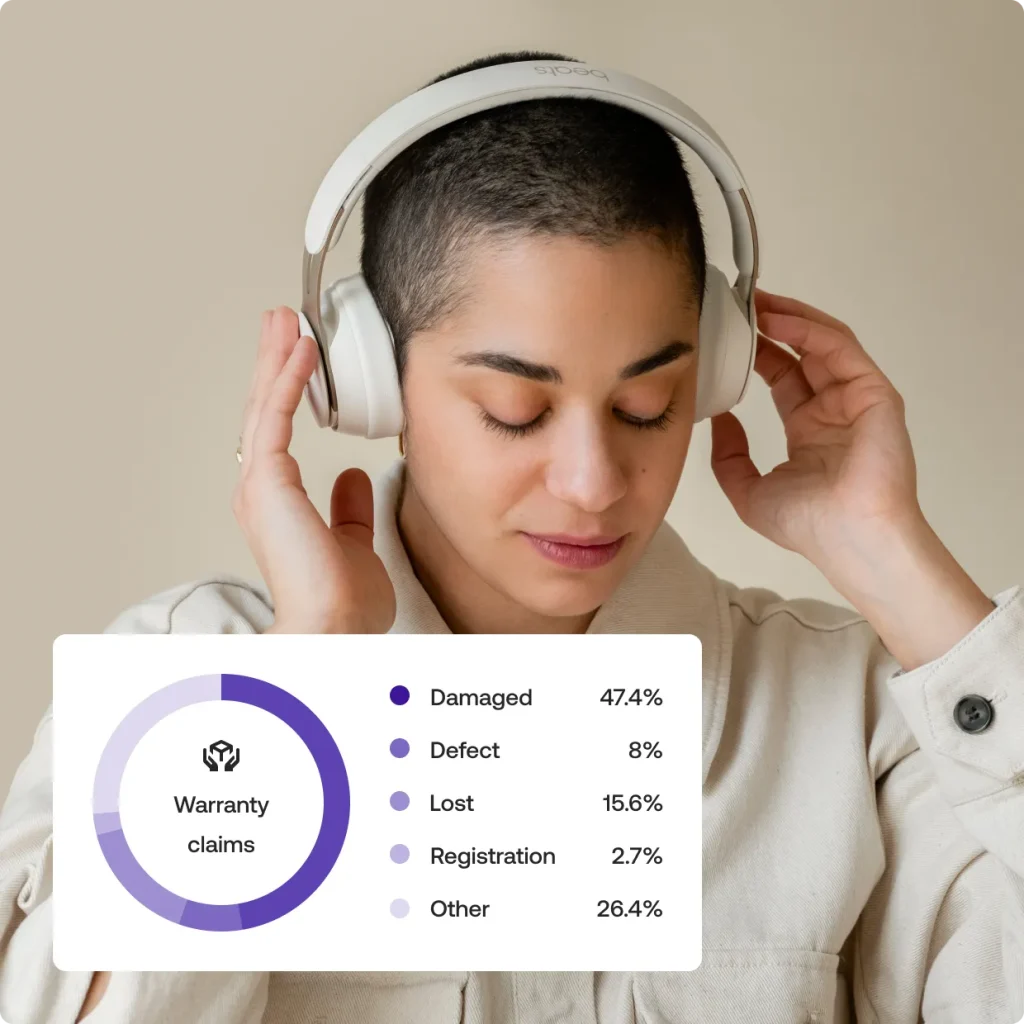
Want to know more about warranty returns? You’ve come to the right place.
Product warranties have become a popular method for ecommerce retailers to prove the quality of their products to their customers. Product warranties, or product protection plans, are service contracts that protect products from certain damages or accidents.
Retailers in markets such as Jewelry, Eyewear, CBD/Vape, Health + Beauty, Home, Electronics, and Swimwear use product warranties to show their customers that they stand behind what they sell.
The average refund rate from a manual warranty process.
The average number of manual touchpoints to process a warranty return.
Average time to process a manual warranty return for a customer service rep.
While warranty programs are great, having to deal with warranty requests can pose a lot of challenges to retailers. After talking to hundreds of ecommerce merchants about warranty requests, listening to their pain points, analyzing their data, and finding a solution that will fit any retailer’s glove, we decided to take things a step further; to educate you on our findings.
The fact of the matter is there’s not much information out there on managing warranty requests. So, we created this guide to give you what you need to know.
In ecommerce, when a customer finds your product, that’s a win. When they buy your product, that’s a bigger win. The item arrives on time. Yet another win. It’s exactly what they wanted. That’s game over, right?
Not always. If your business stands behind the quality and performance of the products you sell, then a warranty return will eventually derail your winning streak. But that doesn’t mean you have to take it as a loss.
In competitive markets, a product protection plan can offer a significant advantage. While retailers may refer to it in different ways – warranty returns, warranty claims, warranty requests, warranty RMAs – the bottom line is that something went wrong, and now the product needs repair or replacement. A retailer’s ability to respond to the problem efficiently and effectively can be the difference between a loyal customer and a negative review.
By 2027, the extended warranty market is projected to eclipse $170 billion. According to our research, more than 35,000 Shopify stores offer a warranty program. At ReturnLogic, we’ve processed more than 500,000 warranty claims on $50 million worth of goods. It’s not a part of your business you can afford to ignore.
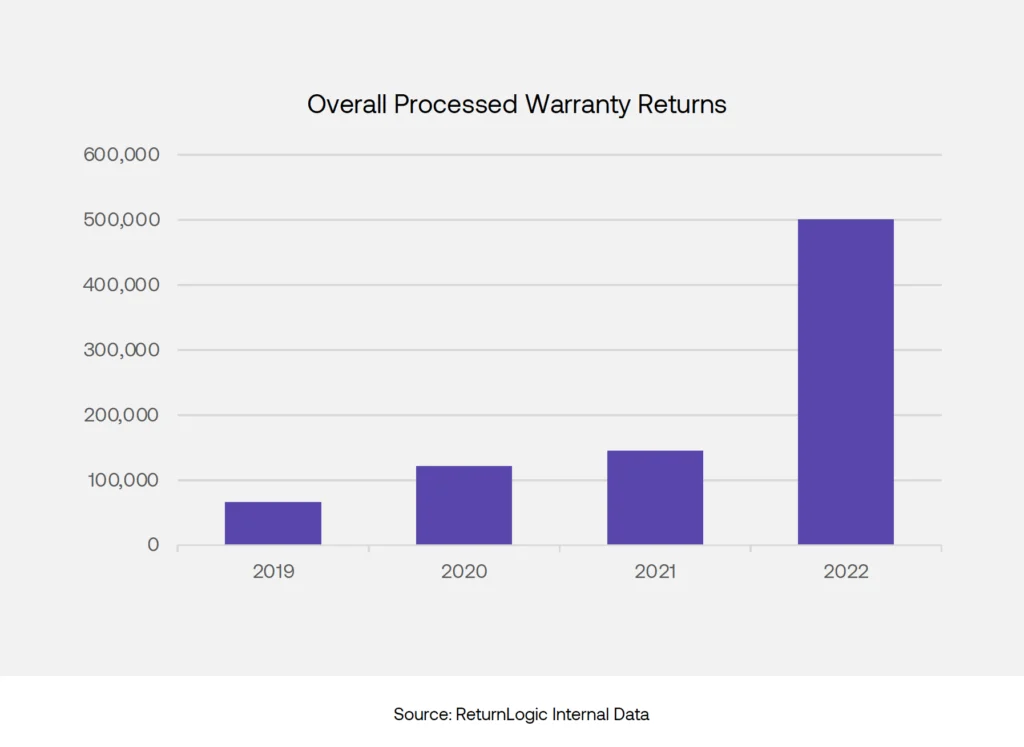
But before we dive into how the warranty return process can drive sales and create value, let’s cover the basics a little more thoroughly.
A warranty return is one of the four most common types of returns that online merchants encounter. Manufacturers typically offer warranties to provide protection for a period of time after a purchase, when the product is expected to operate properly. If a defect causes the product to fail before the warranty ends, the customer can initiate a warranty return and receive a repair or replacement product at no additional cost. Most of the time, if a customer purchases directly from the manufacturer, the seamless capture of information activates the warranty returns policy automatically.
But what if the buyer purchases the product from a third-party shopping platform, such as Amazon or eBay? In some cases, the selling site provides a unique claims process for damaged or defective items, and the customer can obtain a repair or replacement without the manufacturer’s involvement. However, the window for such a resolution may be much shorter than the warranty return time frame.
In these circumstances, a product registration program can be vital for sellers operating in a multi-channel environment. Product registration allows buyers to share their purchase data with a manufacturer. For example, in exchange for submitting contact information, a serial number and the date of purchase, a customer gains the benefits of the extended warranty and can get updates or special offers from the company.
Unequivocally, yes. Returns are one of the most complex and pervasive challenges in ecommerce. They cost you sales revenue, incur shipping and labor expenses, and can result in a negative customer experience if not managed properly.

Customer warranty and return software can provide much-needed visibility into returns data. While some retailers may think they can get by with a simple warranty returns app, the better solution is to integrate a robust warranty returns platform. Comprehensive software is the only way to effectively capture and utilize returns data in a strategic approach that will create new avenues to streamline and grow your business. Top warranty returns tools can:
As mentioned, for businesses looking to scale up and capitalize on new sales channels a warranty platform for Shopify can also integrate a third-party warranty program that collects buyer data from alternative online marketplaces.
Currently, 99.9% of Shopify retailers rely on a manual process when a customer returns a product under warranty. Why does that matter? Just as it is with other return types – exchanges, store credit, refunds – manually handling warranties is time-consuming, expensive, bad for shoppers, annoying for customer service teams, chaotic for warehouse operations, and a missed opportunity for owners and founders who are not seeing valuable data.
Many businesses also make the lack of automation worse by isolating warranty returns in a separate workflow. Regardless of the details found in a product warranty return policy, retailers should instead treat warranty requests similarly to other returns. Otherwise, creating two unique systems for returns and warranties can result in double the work. Not to mention, there’s the added expense of maintaining multiple software systems and the labor and training demands of operating them. It’s clearly a costly mistake once you realize that manually managing each warranty return, on average, requires 10 touchpoints, takes 15 minutes, and costs your company $5 per claim.
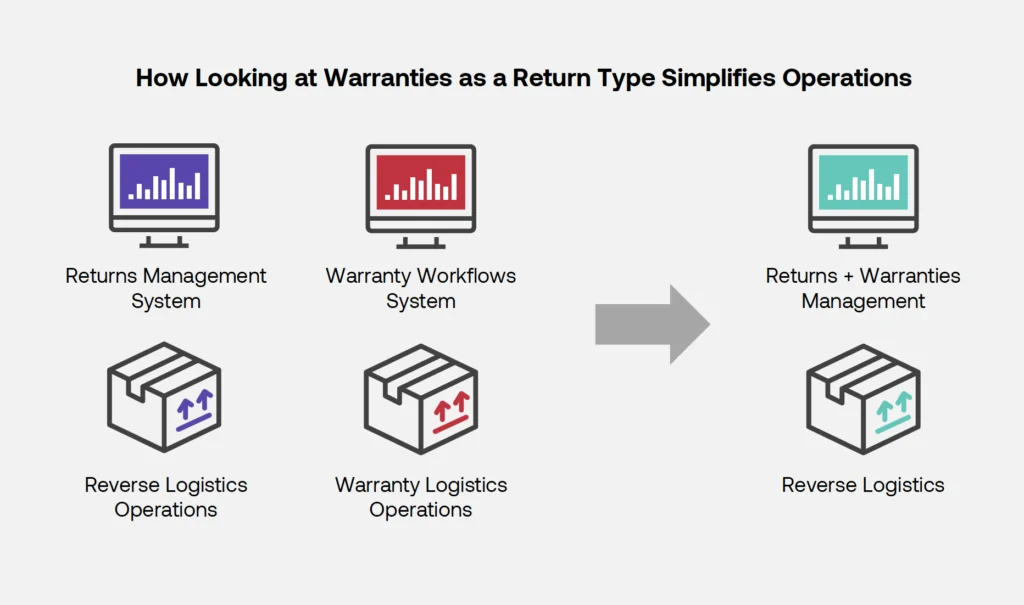
One of the most significant problems that arises from using a manual process for returns and warranty requests is the extended timeline that customers face. Of course, the type of product, availability of replacement parts or products and the specific complaint will all contribute to the time needed to resolve a warranty claim. Unfortunately for buyers, a lack of automation means they could be waiting as long as three weeks to be made whole.
First, retailers with siloed systems may have difficulty providing accurate information about a product’s warranty coverage, leading to customers’ confusion and frustration. They can also struggle with keeping track of customer information and warranty-related documentation, making it difficult to process warranty returns efficiently.
On the operations side, slow or ineffective communication with manufacturers or suppliers can mean delays in getting replacement products and long wait times for customers. In addition, it can be challenging to keep customers informed about the status of their claims without an integrated management system and adequate tracking in place for an incoming warranty RMA (Return Merchandise Authorization). And a disjointed shipping and handling process for returns will likely add additional time and expense to the experience.
For many retailers, the reluctance to replace the traditional, manual returns process is due to their emphasis on control during each one of the warranty return procedures. While your business may see the value of a portal that shoppers can use to initiate a warranty return, you might consider automation a risky proposition. The fear that ineligible claims will be approved or the desire to troubleshoot a product complaint before accepting a claim can cause understandable hesitation. Opting for a manual review of the circumstances when customers are returning a product under warranty can seem like it provides more options and flexibility, such as the ability to accept warranty claims that fall outside a company’s warranty policy.
However, an automated returns process can be just as flexible with less hassle. For example, ReturnLogic can also automate the requirements that help authenticate claims and troubleshoot the reason for returns. An automated process can immediately match return requests to purchases from the seller or allow the buyer to upload proof of purchase from a third-party. Requiring a photo upload can provide additional documentation of the problem and ensure a customer isn’t sending back a functional item simply to get a newer one. Photos also help a company evaluate the potential of repairing the issue.
Integrating a serial number requirement supports root-cause analysis of warranty issues by identifying manufacturing issues that might affect certain batches of products. With many options available, automation can be adopted to varying extents, and in a way that meets the specific needs of your company and its customers.
While automation may not be the answer for every step of a return, there’s no doubt that companies can benefit from streamlining the process wherever possible.
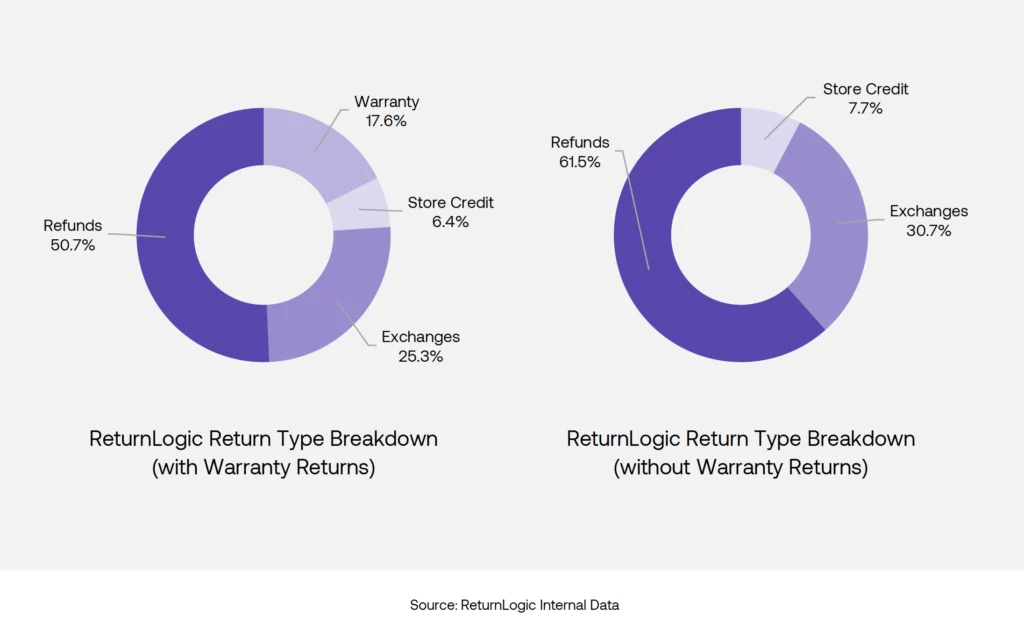
Shopify retailers can incorporate return management software into their stores to automate the return request and approval process. This can include sending automated emails to customers with instructions on initiating a warranty return or automating the approval process so that returns are processed quickly and efficiently.
Retailers can also use the software to track warranty returns, including the status of each return and any relevant information, such as the reason for the return or the customer’s contact information. Access to this data helps companies manage the warranty return process more effectively and improves the experience by keeping customers informed about the status of their returns.
The shipping and handling processes are yet another area that retailers are often eager to optimize. Shopify warranty returns software can automate the shipping label creation process and simplify coordination with manufacturers or suppliers to ensure that replacement products are sent out promptly.
A Shopify warranty platform can also include or sync with customer relationship management (CRM) software to modernize communication with buyers. Stores can use CRM software to manage customer interactions, such as sending emails or text messages with updates on a product’s warranty coverage, the status of submitted claims or the release of complementary products. In addition to CRMs, retailers often use help desk tools like Gorgias, Gladly, or ZenDesk. A help desk option can support real-time communication with shoppers prior to the shopper submitting their full claim or used to gather more information around the claim. Regardless, it’s important to integrate your help desk with a warranty management platform to make sure customers are always up to date. Done correctly, customer support reps will also have the convenience of having all relevant information readily available instead having to jump back and forth between tools
Obviously, choosing to automate one or more areas of the warranty process offers Shopify retailers an opportunity to streamline returns, reduce errors, and provide a better customer experience. But it can also support efforts to expand a seller’s reach.
As companies scale, they look to sell on more channels. This includes marketplaces like Amazon, eBay, Walmart and Facebook. However, expanding to multiple sales channels and having warranty returns from each can be chaotic. Not to mention, your company loses access to critical data from the sale.
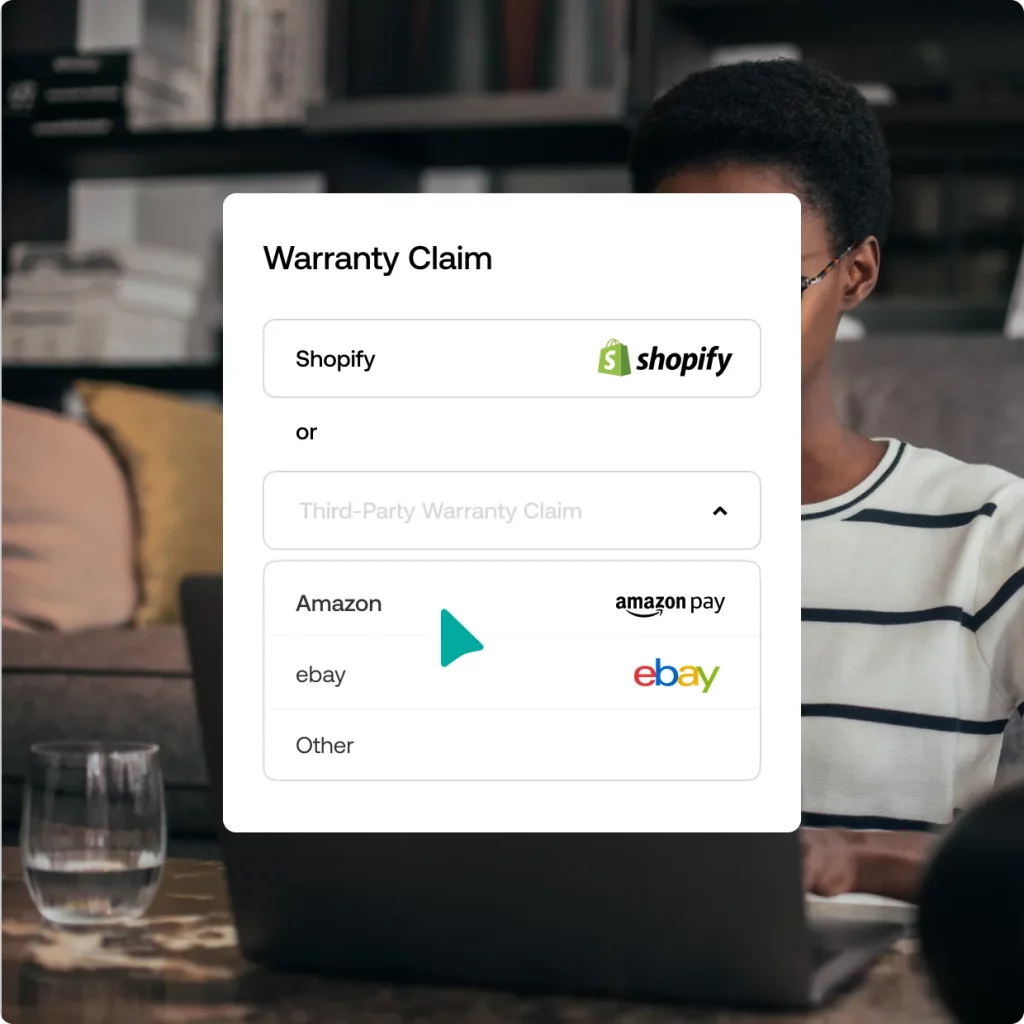
The solution we discussed earlier is to launch a third-party warranty program, also known as product registration. In this scenario, when someone purchases a product outside of your Shopify store and wants to get a replacement or repair under the warranty policy, they must first visit your website and enter details about the transaction and item to register that product.
It’s a lucrative tactic for retailers because it allows them to grow their marketing lists. Without the third-party warranty, they would not have known about these customers. But product registration provides data on what they bought, when they bought it, their contact information and more. All of these details can be used to market to those people and, hopefully, develop repeat shoppers.
Among ReturnLogic retailers, approximately 25% of warranty claims are made by shoppers who purchased from a third-party marketplace. Accordingly, getting the most out of these types of third-party warranty programs also requires an ability to merge the data collected with information from your other warranty claims. Doing so results in greater insight into potential product issues and customer behaviors. The best warranty returns software can make this task much easier and reduce the burden on your customer service team.
Warranty programs make a purchase feel secure and put consumers at ease about the post-purchase experience. According to Mulberry, nearly 50% of consumers are more likely to choose brands that offer protection plans. By simply offering product protection, more shoppers are likely to convert to customers.
But like any support ticket, a warranty claim is a problem a shopper wants to be solved. And most sellers realize their customers want it addressed as quickly as possible. So providing a portal for shoppers is ultimately the most convenient option when someone wants to return a product under warranty to the manufacturer. It also follows through on the promises made in your warranty policy in a customer-centric way and demonstrates that you’re dependable and prioritize customer satisfaction.
If a customer has additional questions or concerns, they can always reach out, but in most cases, a self-serve warranty returns workflow is the quickest and most effective option. The sooner the situation is resolved and the better your communication is along the way, the better. This is why automation can often turn a negative experience into a positive experience that keeps your customers happy with your brand, increases retention and improves Customer Lifetime Value (CLV).
Would you rather your customer service team spend its time focused on the customer or internal procedures? Unfortunately, the latter becomes nearly inevitable when retailers depend on a manual mechanism to manage warranty return claims on Shopify.
The workflow from customer complaints to warranty RMA is tedious without an automated system. Support representatives become responsible for looking up orders, checking compliance with the warranty policy, creating shipping labels and logging each step along the way.

Thanks to an automated returns program, a customer wanting to report a warranty issue on a product won’t monopolize your employees’ time. It can eliminate the time-consuming steps and the need to go back and forth with shoppers. Customer service teams won’t have to email or copy and paste the initial request across multiple communication tools or constantly return to them to check for updates from other departments. They can also ditch long warranty return forms that shoppers fill out but then have to be transferred to internal spreadsheets.
In our experience, retailers who automate via a top warranty returns tool for Shopify can significantly enhance their customer service capabilities. Often, this results in a drop in refund rates, improved processing time and skyrocketing customer satisfaction. In fact, it’s not unusual for refunds to fall by as much as 30 percent. In addition, ReturnLogic clients also dramatically cut the time it takes to complete a warranty return, with most accomplished in days or even minutes, instead of the weeks a manual process can require.
Your customer-facing front line is not the only part of your business that can reap the rewards by transitioning from a manual approach to an automated one for warranty returns on Shopify. Warehouse and operations teams are also primed to capitalize on the improved processes.
Without automation, the warehouse team typically must juggle the responsibility for warranty return procedures with the customer service department. Once the warehouse receives a warranted product from a shopper, they can inspect it and determine the appropriate disposition, usually either re-stocking or liquidating. A replacement item may need to be shipped back to the customer in many cases. However, all of this can require manual updates to document the item condition and adjust inventory levels so that everyone has access to the most current status.
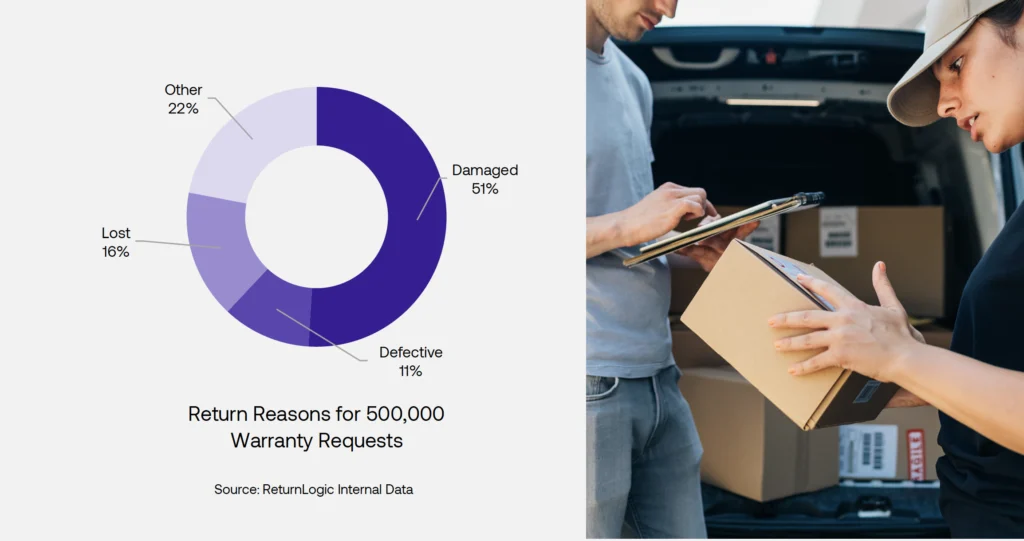
This endeavor can become much more streamlined with a warranty returns management tool for Shopify, like ReturnLogic. For example, an outgoing shipping label in response to a return can be created automatically based on the approval of an exchange. At the same time, the status is seamlessly updated for all relevant teams as the return moves through each step. Of course, since more than 60% of warranty returns are due to a damaged or defective item, this disposition data must be analyzed carefully.
Most common warranty return reasons
Completing a return under warranty via ReturnLogic can also aid the warehouse team in choosing the next step for the returned item. Depending on the product’s condition, you can implement a workflow that directs the return to its next destination, whether that means re-stocking, refurbishment, liquidation, donation or something else.
Warranty programs provide a statement that retailers stand behind their products. However, if a shopper submits a claim, that means something went wrong. In the most basic sense, warranties are problems with the product. Unlike other return types where shoppers can start a return if they don’t like the size or color, warranties mainly apply to items that fail to perform as promised.
With that being said, a manual warranty return process and disjointed spreadsheets will not tell a retailer if they have a faulty SKU or defective product line. Even with the help of a complicated pivot table, the data is still likely to be a mess that can’t provide the valuable insight a retailer needs to make well-informed and strategic decisions. Without collecting the appropriate data and the ability to generate reports quickly, retailers will not be able to complete the root-cause analysis necessary to identify trends and improve their products.
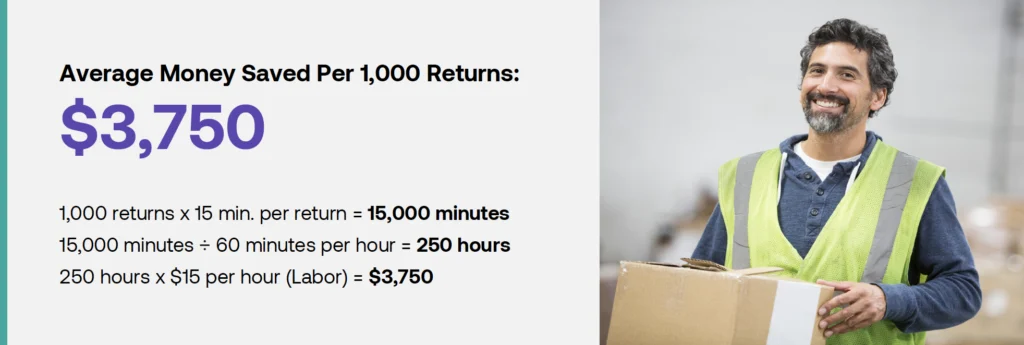
It’s difficult to overstate the impact of post-purchase warranty experiences on business growth. It affects retention, churn, and CLV significantly. A poor warranty returns experience, often due to manual methods, leads to customer churn. And you don’t just lose that particular sale. You lose out on every future sale that person would have made had they not had a bad post-purchase experience.
A lack of automation and data collection makes the problem worse since it can be impossible to know when or why a shopper has churned. The result may be that you waste new marketing dollars on them, making the problem more expensive.
Without a doubt, automating warranty returns and focusing on delighting the shopper helps improve retention, and average order value, while boosting CLV. But how, exactly, can disposition data mitigate warranty returns? It starts by providing:
Insight into product performance: By analyzing disposition data, retailers can identify trends in product performance, such as which products are most likely to be returned due to defects. This information can help retailers make informed decisions about which products to carry and can help reduce the number of warranty returns.
Better quality control: Identifying the root causes of warranty returns through disposition data analysis allows retailers to target their quality control processes and reduce the number of defective products sold to customers.
Improved supplier relationships: Sharing disposition data with suppliers allows a retailer to work with partners to identify and resolve product issues, reducing the number of warranty returns and improving supplier relationships.
Higher customer satisfaction: Fewer warranty returns lead to more customer satisfaction and stronger customer loyalty to retailers.
Reduced costs: Warranty claims, shipping products back and forth, and handling customer complaints are all expensive. Minimizing the number of claims and making the processes in place to deal with them more efficient saves both time and money.

A strong warranty return program can be a huge advantage for retailers. The proof can be found in the growth of companies that prioritize warranty returns as a critical component of customer service. These retailers know that a siloed process comes at the cost of frustrated buyers, more expensive operations and damaging blind spots. Below are two companies that are reaping the rewards of an automated warranty returns system.
This sunglasses company works hard to put the fun in functionality. And they stand behind their efforts with a 30-day free returns policy and a 1-year warranty program. But, while a customer-friendly approach can help build a brand and encourage loyalty that maximizes CLV, it also introduces challenges.
On average, goodr processes 3,000-5,000 warranty returns a month during the summer season. Previously, a tedious manual process meant that more than a half-dozen employees struggled to track and log each warranty request manually. It quickly became a chokehold as goodr grew, and a better, automated system was the only logical solution.
With help from ReturnLogic, warranty returns are now easier for both customers and the goodr team. A customized portal on the company’s website funnels requests directly to the team after ensuring their legitimacy and alignment with the return policy. The vetted claims are then resolved through an automated replacement process.
The implementation of a better process solved one of the business’s “biggest problems,” saving time, labor and money that goodr could allocate in pursuit of new goals. Really, what’s more fun than that?
There’s no better way to instill customer confidence than a “94-Year No BS Warranty” that even covers lost items. Well, as long as you have a warranty return process that can live up to the promise.
Groove Life initially handled warranty claims for its line of silicone accessories for adventurers only via phone and email. The manual approach limited the company’s capacity to respond to customer inquiries to about 1,000 per day. However, adding a Returns Management Platform from ReturnLogic to their Shopify store increased that by 60%, allowing them to serve another 600 customers each day.
Now, buyers with concerns about a product can call, email, text or use the ReturnLogic portal. And regardless of which path they choose, the process is aligned to provide each customer with a streamlined experience.
More importantly, Groove Life is also learning from every return. They can spot items with high return rates, uncover faulty manufacturing issues and eliminate bottlenecks in the reverse supply chain. Complete warranty claim automation and more communication across their business data tools are also within reach, thanks to the elevated experience provided by a comprehensive customer warranty and return software.
As seen on IGN, Forbes, and Wired, Backbone Labs creates mobile gaming controllers that turn smartphones into gaming consoles. Coming in at #3 on Similarweb’s top 100 consumer electronics, Backbone has seen impressive year-over-year growth. But, as importantly, they can help answer the question, “Are third-party warranties worth it?”
Like many retailers, Backbone doesn’t sell only on Shopify. Their growth is also thanks to sales on other channels such as GameStop, Target, and Best Buy. Along the way, the company has done an incredible job of encouraging shoppers buying from outside their primary site to register their products. The payoff from this effort comes in the form of an expanded mailing list and access to a substantial amount of data they would have otherwise overlooked.
On top of that, Backbone is blending its warranty request data with product disposition data to help illuminate trends about faulty products. They are also taking the vital step of addressing the identified problems to improve their products and keep shoppers happier for longer. Overall, Backbone’s comprehensive warranty request experience makes it simple for shoppers to register their purchase, no matter where they bought it, and get a replacement when necessary. That way, shoppers can keep turning their iPhones into gaming consoles, and the brand can continue growing.
Like many other aspects of today’s digital culture, the future of warranty requests will be driven by consumer data and personalized to individual shoppers. We expect this shift to be showcased in several ways across Shopify sites and elsewhere.
As companies begin to better segment their customers based on their lifetime value to the business, it’s likely that, depending on their status, the process for how to return a product with a warranty will vary. For example, a shopper with a higher CLV might get a free label and free return shipping. However, a first-time shopper might have to pay for the label and shipping. This VIP treatment for the most profitable customers will be automated based on the original order’s unique identifiers.

Another feature aimed at customers, which is already occurring, is that retailers will begin to publish return rates, warranty scores, warranty case durations, and similar details on product description pages. The goal, of course, will be to drive conversions and increase loyalty.
On the retailer operations side, Returns Management Platforms will be much more capable of flagging conclusions for the data as it is collected. Retailers may get real-time, actionable alerts about product failure rates or high return rates. We think many companies would jump at the chance to know immediately that a particular item has a “40% return rate over the last 30 days” or another has “come back as damaged 50% of the time.”
New APIs will also unlock the data flow for all tools in the reverse supply chain. Much like the current returns ecosystem, there’s little scaffolding to connect help desk software, third-party shipping logistics, inventory databases and customer management systems. These tools all contain returns data, but it’s siloed. As advancements become available, warranty returns data will flow through all of these tools seamlessly so retailers can stay ahead of warranty returns instead of reacting to them.
If you’re looking for help making the most of the opportunity that warranty returns present as you grow, ReturnLogic is here. We started as merchants, just like you, and we use that experience to your advantage. Our approach is to deliver continuous improvement strategies that can turn a buyer with a complaint into a lifelong customer. Our warranty returns technology allows retailers to enhance the shopper experience, improve operational efficiency, and grow profits.
We know that managing and responding to warranty claims is costing you more money than it should, and you probably aren’t learning anything from them either. That’s why our integrations are designed to knock down data silos and create solutions that are ready to scale. Schedule a demo today to find out more.

Dive right in to our latest blogs, ebooks and videos!

Get a live demo from one of our product experts and get all your questions answered.
“ReturnLogic takes a lot of extra work off me and helps me focus more on our customers. I love looking at analytics and love that all the information is at my fingertips.”

Amanda Schermerhorn
Director of Operations, Darn Good Yarn

Please complete and submit the following opportunity registration form for evaluation by the ReturnLogic team.
Once your registration has been received, ReturnLogic will provide an email notification within three (3) business days indicating the status of your opportunity.
The ReturnLogic Deal Registration Program is designed to reward our partners for their part in influencing the sale and uses of ReturnLogic products. This form must be completed and submitted for approval.
If you have any questions, please email ericchini@returnlogic.com
Free Return Policy Template
In this free template, you’ll learn how to write a return policy for items that:
free calculator
This customer lifetime value calculator was created for e-commerce brands. Simply follow the instructions in the video below to get an accurate calculation of your customer lifetime value based on our formula.
**When pasting data into the worksheet, use the “Paste Formatting” method.**